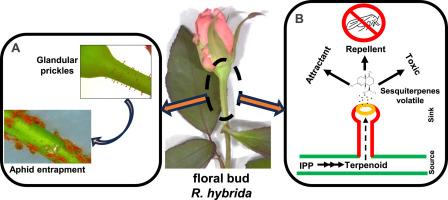月季花的腺刺积累特定的倍半萜类化合物,与防御蚜虫有关
IF 3.8
Q2 BIOTECHNOLOGY & APPLIED MICROBIOLOGY
引用次数: 0
摘要
玫瑰是一种具有巨大观赏价值和经济价值的植物,经常被食草和昆虫所侵扰。为了克服这个问题,玫瑰植物进化出了表皮附属物,即皮刺,它积累了独特的次级代谢物,保护玫瑰植物免受害虫的侵害。主要在茎和叶上发现的坚硬、尖锐的附属物被称为非腺刺(NGPs)。有趣的是,玫瑰的花蕾和叶柄下面有明显柔软的腺状附属物,称为腺刺(gp)。ngp结构尖锐,积累次生代谢物,具有保护植物免受食草动物侵害的作用;然而,全科医生的相关性尚不清楚。鉴于它们在花蕾下的存在,我们推测gp可能参与了对害虫的防御。蔷薇(Rosa hybrida cv.) gp形态、多样性及发育的研究。‘Superstar Supreme (SS)’在开阔的野外条件下显示,gp是表皮/皮质的外生物,具有多细胞柄和腺状头部,其腔似乎可以释放渗出物。有针对性的生化评估显示,次生代谢物(包括木质素、黄酮类化合物和萜烯)的积累(并在渗出物中释放)可能与防御害虫有关。与此一致的是,红色蚜虫被发现困在花蕾下方的GPs中,这加强了GPs或渗出物可能含有昆虫引诱剂和杀虫代谢物的观点。乙酰胆碱酯酶抑制试验表明,GPs具有杀虫潜力。非靶向代谢物分析揭示了挥发性倍半萜烯的积累和释放,如β-顺式石竹烯、γ-茂烯和β-Copaene,可能通过直接杀虫作用或吸引捕食者以它们为食来阻止蚜虫。这些发现提供了重要的见解,即玫瑰的gp积累了特定的次生代谢物,并参与防御蚜虫,保护新生长的花芽。本文章由计算机程序翻译,如有差异,请以英文原文为准。

Glandular prickles in Rosa hybrida accumulate specific sesquiterpenes implicated in defense against aphid pests
Rose, a plant of immense ornamental value and economic importance, is often infested by herbivory and insectivory. To overcome this, rose plants have evolved epidermal appendages, namely prickles, which accumulate distinct secondary metabolites that protect the rose plants against pests. The hard, edgy, and sharp appendages found mainly on stems and leaves are called non-glandular prickles (NGPs). Interestingly, rose plants bear distinct soft and glandular appendages, which are present beneath the flower bud and petioles, referred to as glandular prickle (GPs). The NGPs, being sharp structures and accumulating secondary metabolites, are implicated in protecting against herbivores; the relevance of GPs, however, is unclear. Given their presence beneath flower bud, we speculated that GPs might be involved in defense against insect pests. Investigation of morphology, diversity, and development of GPs in Rosa hybrida cv. ‘Superstar Supreme (SS)’ in open field conditions revealed that GPs are epidermal/cortical outgrowths with a multicellular stalk and a glandular head with a cavity that seems to release exudates. The targeted biochemical assessment revealed an accumulation (and release in exudates) of secondary metabolites, including lignin, flavonoids, and terpenes, that were likely involved in defense against insect pests. In agreement, red-colored aphids were found trapped in the GPs beneath the floral bud, reinforcing the notion that GPs or exudates likely contain insect attractants and insecticidal metabolites. Acetylcholine esterase inhibition assay indicated the insecticidal potential of GPs. Untargeted metabolite analysis revealed accumulation and release of volatile sesquiterpene hydrocarbons, such as β-cis-caryophyllene, γ-muurolene and β-Copaene, that likely deter aphids by either direct insecticidal effect or attracting their predators to feed on them. These findings provided significant insights that GPs in rose accumulate specific secondary metabolites and are involved in defense against aphid pests, protecting the newly grown floral bud.
求助全文
通过发布文献求助,成功后即可免费获取论文全文。
去求助
来源期刊

Biocatalysis and agricultural biotechnology
Agricultural and Biological Sciences-Agronomy and Crop Science
CiteScore
7.70
自引率
2.50%
发文量
308
审稿时长
48 days
期刊介绍:
Biocatalysis and Agricultural Biotechnology is the official journal of the International Society of Biocatalysis and Agricultural Biotechnology (ISBAB). The journal publishes high quality articles especially in the science and technology of biocatalysis, bioprocesses, agricultural biotechnology, biomedical biotechnology, and, if appropriate, from other related areas of biotechnology. The journal will publish peer-reviewed basic and applied research papers, authoritative reviews, and feature articles. The scope of the journal encompasses the research, industrial, and commercial aspects of biotechnology, including the areas of: biocatalysis; bioprocesses; food and agriculture; genetic engineering; molecular biology; healthcare and pharmaceuticals; biofuels; genomics; nanotechnology; environment and biodiversity; and bioremediation.
 求助内容:
求助内容: 应助结果提醒方式:
应助结果提醒方式:


